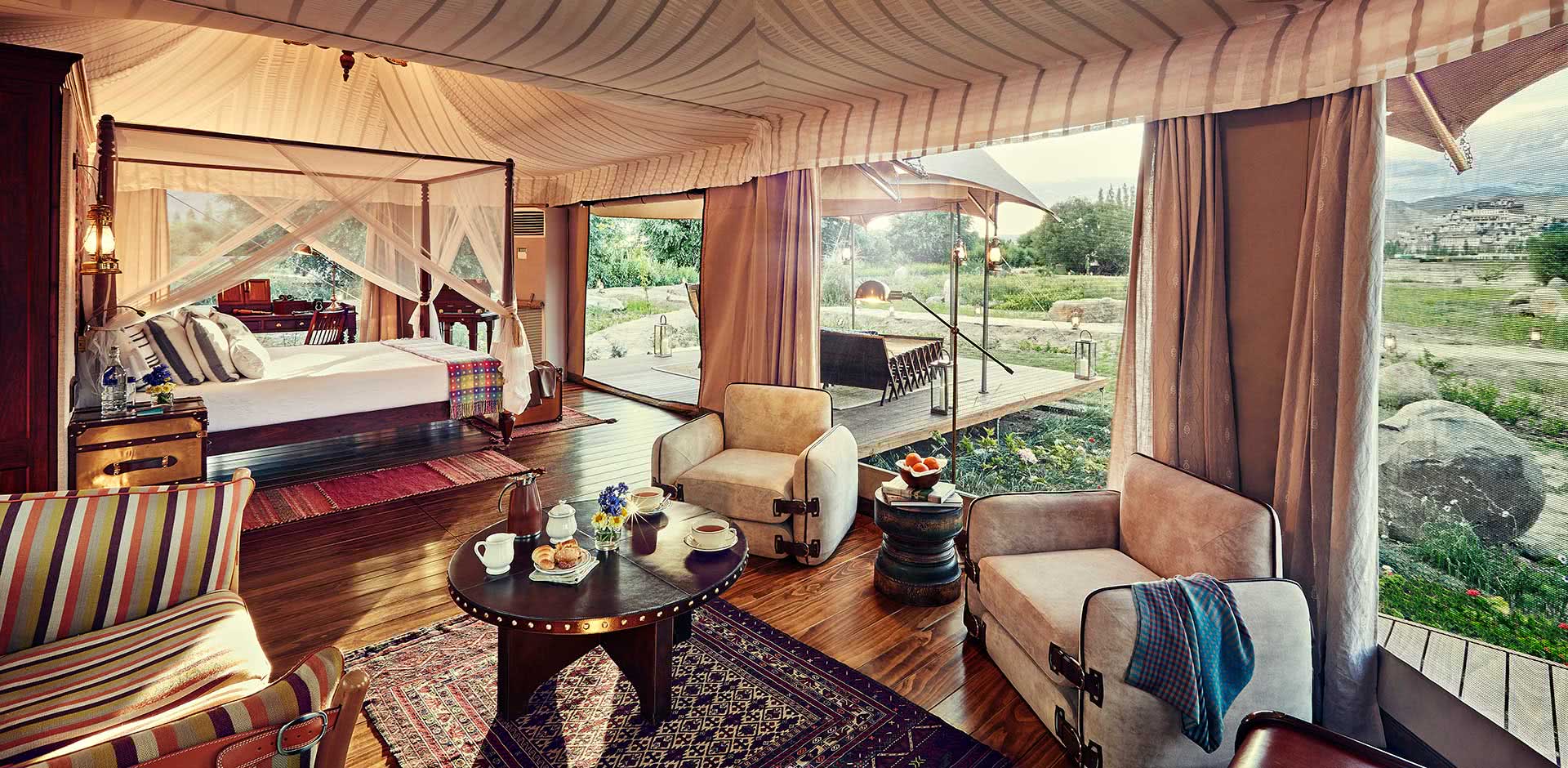As our plane began its descent in to Leh, I could not help but be taken in by the sheer beauty of the snow-capped peaks of the Himalayas rising above the rugged Martian landscape – an impression that would be answered by many more similarly epic vistas across the “land of high passes” – home to spectacular jagged peaks, aquamarine lakes, striking monasteries, fluttering prayer flags, red-robed monks, and white-washed stupas. These northern reaches of India are known for a marked spirituality, nomadic lifestyle, and sheer remoteness. It is here that you know you are a traveler – not a tourist.
We were whisked away from the bustling little airport, catching our breath as we went; the altitude is a stiff reminder that you aren’t in Kansas anymore. Ladakh is a high altitude desert, and due to the extreme weather conditions, the best season to travel here is June to October. I traveled in early June, just at the start of the season, so there was still a chill in the air and snow on the mountains.

After 45 minutes of winding through villages, we arrived The Ultimate Travelling Camp (TUTC) in Thiksey, which sits in a valley under the guise of the magnificent Thiksey Monastery. Warmly greeted, we were ushered in to the main tent that acts as reception, the library lounge and the best chance at an internet connection in the camp. As part of our registration process, the resident doctor checked our blood pressure and oxygen levels to ensure the thin air was not having any adverse effects – and reminded us that as we were at 11,500 feet, we should take it easy, particularly on the first day, while we acclimatized to these heights (which included no wine – a rule we summarily broke within an hour to no ill effects).
The Ultimate Travelling Camp properties throughout India are synonymous with being the ne plus ultra of glamping, and truly the facility could surpass many a 5-star hotel. Nothing exudes luxury more than having all things luxe in a remote destination. Our heated triple-layered canvas tent had gleaming hardwood floors, Kashmiri carpets, a vintage travel trunk, elegant colonial furniture, hot shower, Ayurveda-inspired toiletries, complimentary refreshments bar, ample plug sockets, loungers, bejeweled chandeliers, and 24-hour butler service (who can say no to coffee on call?). The spacious tent sat on a raised thick wooden deck, which also served as a patio giving a splendid view of the yellow-flowered alfalfa field and the majestic Stok Mountain Range – the sheer pleasure of waking up to the Himalayas in your front yard never got old.
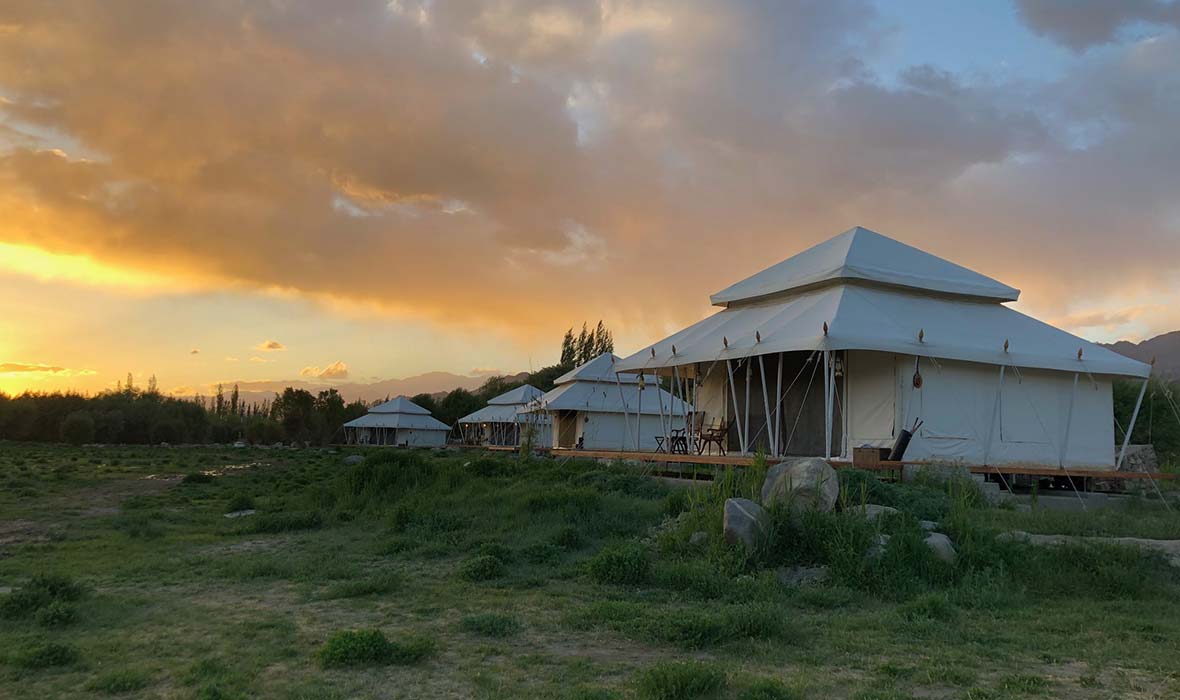
ABOVE: Glamping with TUTC.
Later that evening when we stepped out of our tent, I reveled in the glow of dozens of flickering lanterns. The dining tent was a comfortable affair, with very warm and attentive service and gourmet food for both the Western and Indian palate. I loved the Indian thalis (tasting platters) and feta-laden Greek salads, as well as the decadent deserts that finished each meal. TUTC’s kitchen staff was truly adept at conjuring up all sorts of cuisines – during our stay we had a range of Indian, Continental, and local Ladakhi dishes, all meticulously executed, artfully presented, and uniformly delicious. All meals are inclusive while in residence, and they certainly do as much as they can to fatten you up while there – though be aware that the altitude can rob you of much of your appetite.
TUTC can arrange excursions for you while you are in residence, and our lovely guide and driver stayed with us throughout the entire period. There is so much to do and experience in Ladakh, if you can bear to push beyond the sheer comfort and relaxation offered within the confines of the Camp. On one day we did simple village hike, stopping by the local nunnery and a tiny temple where only a handful of monks reside to join them in meditation and some gur-gur chai, a salted yak butter tea that is by far one of the most unique things you will ever taste.

ABOVE: Overlooking the Indus River.
On another, we headed across the Indus River to the 15th Century Matho Monastery perched high up in the Stok Mountains. Here our guide gave us a crash course on Buddhism, using the monastery’s wall frescos as a guide to the finer points of the religion. Later, we explored the dusty crowded city of Leh – a major center of hustle and bustle…we didn’t last long before we retreated back to the heavenly peace of our remote tented camp.
My favorite excursion was the day we went to Alchi, an 11th Century Monastery founded by Ringchen Zangpo, the Great Translator. Alchi Gompa has a distinct Kashmiri influence in its art and architecture and is home to some of the most exquisite Buddhist frescos murals that I have seen in my travels through the Pan-Himalayan region. One special room had what seemed like 1000’s of images of the Lord Buddha repeated over and over, each one varying in the tiniest of detail. After our monastery visit, we were surprised with a special picnic lunch on a cliff-side overlooking the Indus River – a site that TUTC had sought out to create an unforgettable vista for its valued clients. The mighty river churning below us in an impossible greenish hue that I cannot put a name to, and we were surrounded by spring wildflowers. On the way we passed by Basgo Fort, and stopped at Likir Monastery, which is presided over by the Ngari Rinpoche, a position held currently by the younger brother of the Dalai Lama.
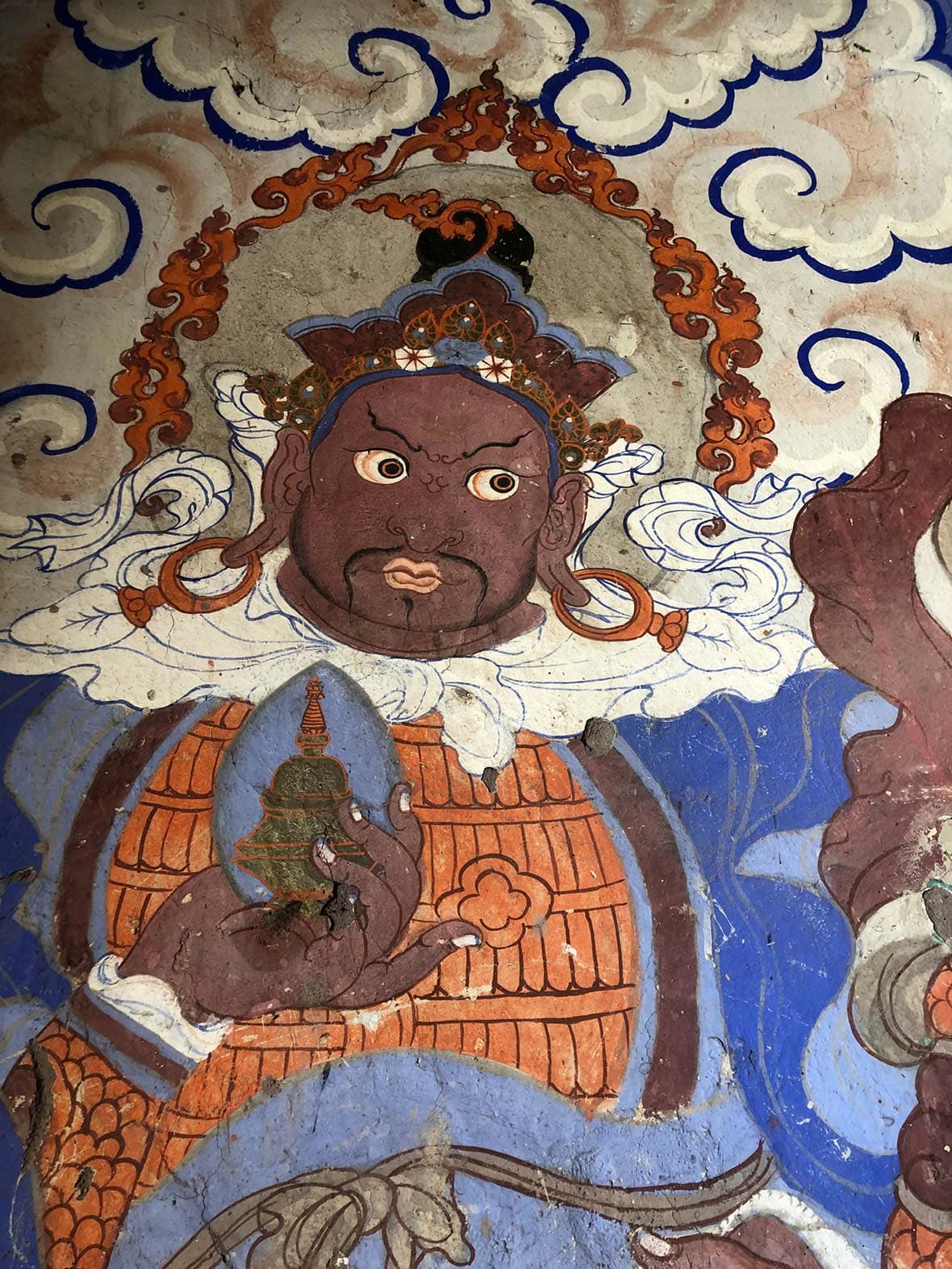
ABOVE: Temple art in Thiksey Monastery.
On one auspicious morning, our guide had us rise in the dark, so we could join the monks of Thiksey Monastery in their morning prayers. Sunrise is early in Ladakh, the tips of the mountains turn pink by 5am and the colors play out over the valley below. As we slowly make our way up the many many stairs leading to the prayer hall, standing on the flat roof are two monks in maroon robes each blowing long trumpets – drungchens – out into the thin mountain air. The deep booming echoes around the Indus valley, bouncing off the slopes, reminding villages for miles around that morning prayers are about to start.
We settle onto rugs in to the back corner, and watch as the monks file in – the eldest at the front, the youngest by the doors. At first the prayers seem very solemn, heads bowed over the text; the chanting is mesmeric and beguiling, even though it’s relatively tuneless. Offerings of rice in round flat dishes are placed in intervals along the benches. A small boy wrapped tight in his maroon robes against the morning chill, leans over to his friend and whispers something into his ear. Without missing a beat, the friend, shoulders shaking with laughter, grabs a fistful of rice and chucks it at him. They laugh so hard they lose their place in the text. Behind them sits an older monk, completely bald, wearing dark sunglasses and mustard colored robes, swaying to the prayers like Stevie Wonder. Nearing the end of prayers, a young monk comes around, offering us gur-gur chai, the warm yak butter tea – and I’m not sure if it’s the altitude, or the early morning, or the sheer joy of being here – whatever it is, I’m weightless.

ABOVE: Yaks of Ladakh.
After a few days at Thiksey camp, it was time to change our landscape and head over to the lesser-visited sister property in the remote Nubra Valley. The road to get here is long and winding, passing through the tawny barren landscape for hours on end, dotted with yak caravans, raging streams and snow covered valleys and glaciers.
We stopped to take a mandatory selfie at Khardung La Pass, which is said to be the world’s highest drivable pass at 18,380 feet (exaggerated erroneously) – truly you feel you are on top of the world for the brief 10 minutes you can stand to breathe the air here. The 7-hour journey at times was both eye-popping and death-defying – a road trip to rival all road trips.
As we descended into the Nubra Valley, we were met by the confluence of two rivers, Nubra and Shyok, flanked by craggy mountains of the Ladakh Range, interspersed here and there with pockets of green where tiny villages had sprung up. The landscape in Nubra is surreal to say the least. The area has historical importance as the valley connected India to the southern branch of the Silk Road trade route from China through the Karkorum Pass, and today has limited tourism due to being a strictly regulated border area (the presence of the Indian Army against the stark, arid landscape is a reminder of its position).
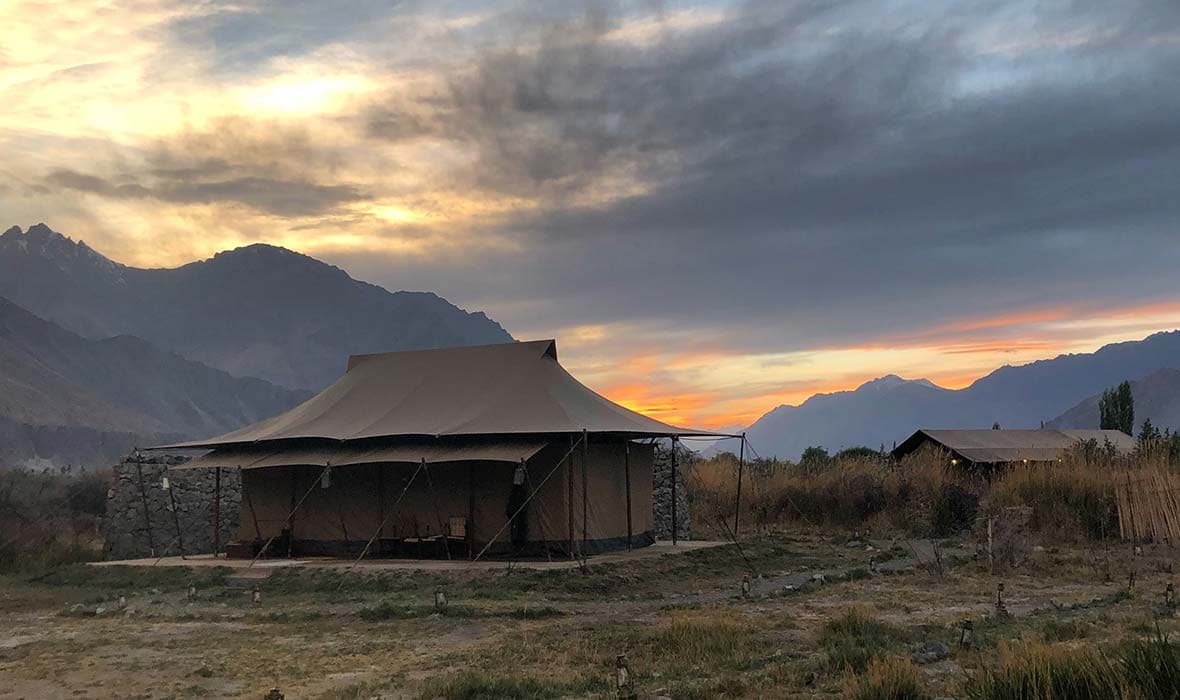
ABOVE: Chamba Camp Diskit.
Chamba Camp Diskit is just outside Diskit village and is done up in a more rustic style compared to the Thiksey camp. The surrounding dramatic landscape added to the rough-and-ready camping vibe. The tent itself was anything but rough – the triple-layered beige tent stood on a solid wooden deck with a private sit-out and an uninterrupted view of the Diskit Monastery, which seems to have been hewn out of the very cliff it stood on. Inside, a four-poster bed, bright orange furniture, and a gorgeous vintage leather trunk-turned-wardrobe completed the African safari-camp-style.
Chamba Camp Diskit offers many excursions as well. While in residence, we visited Diskit Monastery and its 100-foot Maitereya Buddha, which watches over the valley, the sand-dunes at Hundar where we went for a camel ride at sunset and drove out to the holy Yarab Tso Lake for a hike and a visit to a local organic farm house, where the owner joined us for a lengthy discourse on irrigation, farming and Indian politics in the North.
It was only afterwards, that I found out we could have gone a bit further afield to visit the Balti Muslim villages beyond Hunder, and maybe even have a meet the “king” of Turtuk, Yabgo Mohammad Khan Kacho, a descendant of the Yabgo Dynasty that ruled Balistan for 2000 years. Another guest had done this, and I had unmistakable travelers envy. Funny being in one of the most remote and enviable corners of the world and envying someone else’s concurrent travels – I have added it to my bucket list must-do’s for future travel.
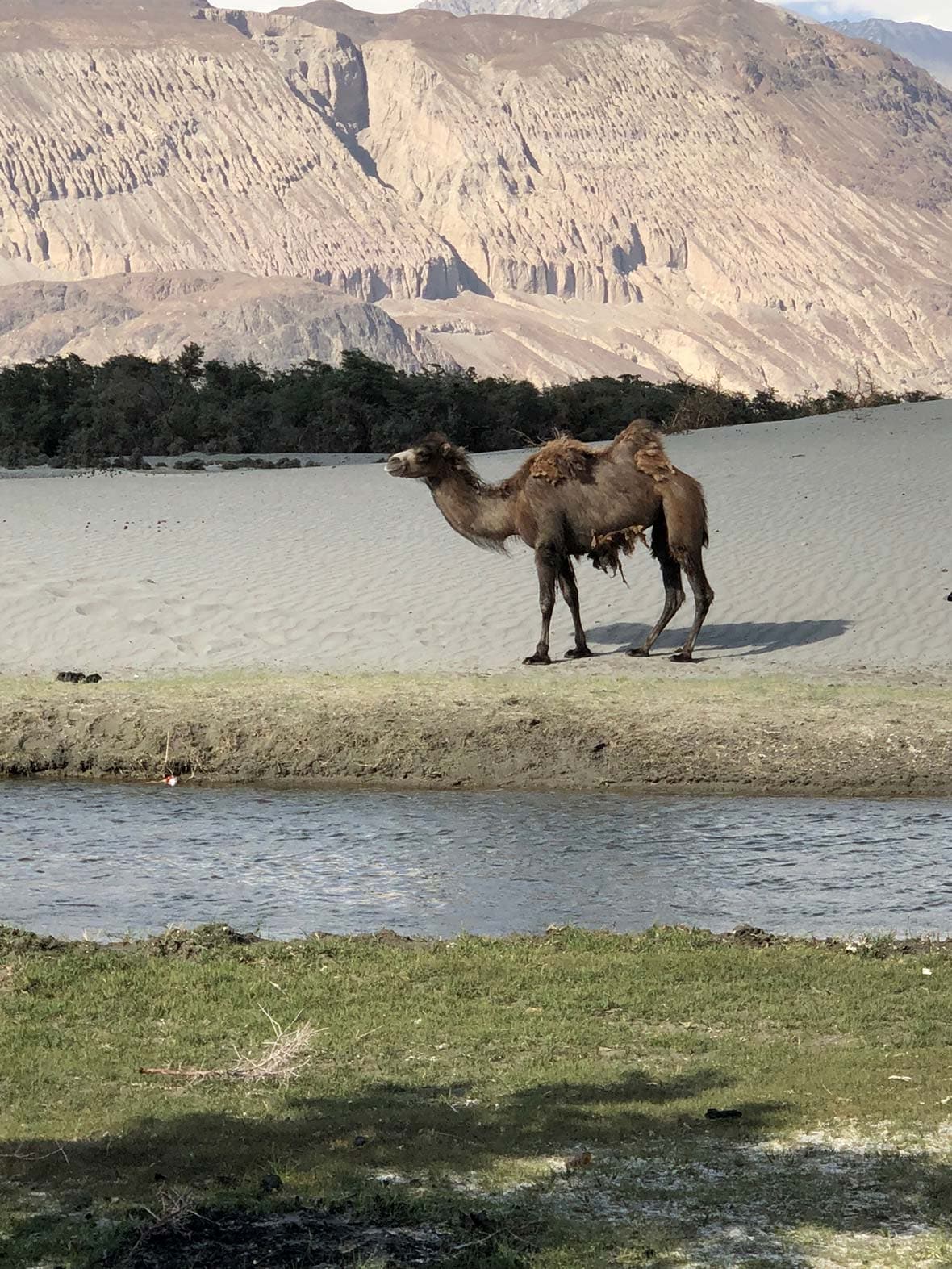
ABOVE: Bactrian Camel in the Nubra Valley.
On our way back, we drove an alternative route, crossing Wari La from Sakti and traveling alongside the Shyok River. Though it was longer, it seemed less treacherous than our arrival journey – and in, my opinion, far more beautiful. The pastoral images of yaks, dzos (a hybrid of a cow and yak), shaggy horses and lightning-quick marmots dashing about amongst the yellow buttercups dotting the boggy marshlands created by the melting snows are seared into my minds-eye.
En-route back to Thiksey, TUTC set up the ultimate lunch for us – a tent with a commanding view down the valley – served impeccably by an army of waiters and chefs. Aside from the billowing gusts of wind that ran down the valley and threatened to topple my champagne glass, this may just be the most epic, or should I say ultimate, luncheon I have ever experienced.
It’s no secret that true luxury lies in slowing down, and you will find that the pace here in this northern corner of nowhere is well suited to embrace this concept. While I certainly explored the area, more precious were the afternoons that I kept to myself to enjoy the impossibly blue sky suspended over my tent, mesmerized by the not-so-distant snow-capped mountains while coming up with names for the many birds that stopped by to say hello. Here, in the far northern reaches of India, deep in the wilderness – away from everything and everyone – I was able to redefine what ultimately made me love travel – the simple act of reveling in the joy of being in the moment.




